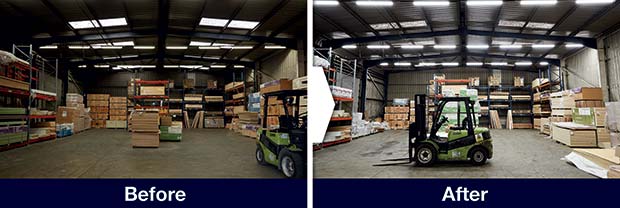A question asked on many occasions is what energy savings can be made when upgrading to LED lighting and by adding smart technology. Our Smart Projects team carry out assessments and consider lighting options and designs before providing results of the calculations. However, it is commonly known that LED upgrades alone can save up to 70% in energy costs. Add smart technology and up to a further 50% in savings is achievable

LED Vs Other Options
The biggest benefit of LED is its energy efficiency. LEDs require much less electricity to power than traditional incandescents, halogen light bulbs and energy efficient light bulbs (CFLs). LED bulbs use more than 75% less energy than incandescent lighting and about 60% less electricity than high-intensity discharge (HID) lamps. At low power levels, the difference is even larger. They also last much longer than their incandescent, halogen and CFL equivalents.
The Role of Sensors
Sensing plays a key role in smart lighting, with one of the major benefits being a considerable increase in energy savings.
With our Smart Commercial Solution our sensors come with a range of functionalities, including the gathering of environmental data and human activity, along with monitoring luminaire performance.
Motion or Occupancy sensing allows for the detection of physical movement. When used in lighting, sensors monitor presence to ensure the lighting remains activated, but where there is little or no movement, lighting either dims or deactivates – saving energy and increasing lifetime. This can be ideal for railway platforms, airport lounges, warehouse aisles, meeting rooms, restrooms, corridors and many other applications.
Daylight sensing allows for daylight harvesting, which takes advantage of naturally available light. Using this type of technology enables automatic brightening, dimming down or turning off when different levels of natural light is entering the space. The more daylight entering the space, the more the lighting will be dimmed and vice versa. A daylight harvesting programme for building lighting can typically deliver energy savings of 20-60%, while providing the assurance that occupants have the right amount of light in the space.
Wireless Lighting Control
Smart lighting control enables businesses to create schedules for when lighting needs to be on or off. Based on regular activity for different spaces, lighting can be scheduled to come on, stay on, remain dimmed, and turn off when required. So, for example, lighting can be scheduled to come on in different areas of the building for when people are due to arrive or when they leave. By scheduling all internal lighting to go off at a certain time every evening prevents any being left on overnight.
Control can be extended further when the lighting system is linked to BMS (BuIlding Management Systems) enabling better energy management of Heating, Ventilation and other systems within commercial and industrial buildings.
Furthermore, smart lighting can also be controlled by businesses remotely, enabling management to temporarily suspend schedules for certain time periods if required.
For more information on energy saving with our Smart Commercial Solution contact our Smart Projects team at info@auroralighting.com or 01793 461 001.




Comments are closed.